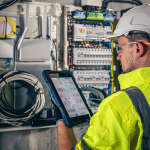The modern automobile is a symphony of technology, with sensors, modules, and systems working in unison to deliver a smooth, safe, and efficient driving experience. Among these, the Adaptive Cruise Control (ACC) system – a feature common in brands like Ford – stands out as an invaluable asset for drivers. Ensuring these systems are properly calibrated is crucial for their optimal operation, and in this article, we will guide you on calibrating the ACC on a new Ford Edge.
Understanding the Importance of Calibration
Before diving into the calibration process, it’s vital to understand why calibration is necessary in the first place. The ACC is an advanced driver-assistance system (ADAS) responsible for maintaining a safe distance from the vehicle in front and automatically adjusting the car’s speed accordingly.
Also to discover : Mobile car wash London: convenient, eco-friendly service near you
Primarily, this system operates using sensors mounted on the vehicle’s front, typically in the bumper or behind the camera. These sensors, along with modules and camera systems, identify and measure the distance to the car in front, sending the data to the control module. If these devices are not accurately calibrated, it could result in false warnings or misreadings, leading to potential collisions.
With the continuous development of ADAS like ACC, the risk of misalignment during regular repairs, part replacements, or even minor collisions has increased. As a result, calibration is essential to ensure that all sensors and systems are aligned correctly and functioning as intended.
Have you seen this : Eco-friendly mobile car wash services in london for your convenience
Calibration of the Adaptive Cruise Control: Procedures and Considerations
Jumping into the calibration process, it’s important to note that each OEM (Original Equipment Manufacturer), such as Ford, has specific procedures for calibration. Therefore, the steps we’ll outline are specific to the new Ford Edge.
To perform the calibration, you will require specialized tools, including a scan tool capable of performing an ACC sensor alignment and the appropriate targets identified by the OEM for this procedure. If you’re not comfortable or equipped to do this on your own, it’s recommended to take your vehicle to a professional technician who can correctly perform the calibration.
The ACC sensor, located behind the Ford Edge’s front bumper, should be the primary focus during calibration. After ensuring the sensor is clean and free of debris, utilize the scan tool to access the ACC module. The module will provide instructions on the necessary adjustments to the sensor’s position.
While performing these adjustments, be aware that the sensor’s view should not be obstructed by any foreign objects, including tow hooks, license plates, or bumper guards. Moreover, Ford specifies that the vehicle must be on a level surface during calibration. Therefore, make sure your location meets these requirements.
Identifying When Your ADAS Needs Calibration
While it’s recommended to routinely calibrate your vehicle’s ADAS, certain situations make it absolutely necessary. For example, if you’ve recently been in a collision, even if it’s minor, the impact could have misaligned your ACC sensors. Similarly, if your vehicle has undergone repairs or maintenance involving the bumper, camera, or ACC sensors, calibration is required.
Additionally, if you notice your ADAS acting differently – for example, if the ACC is not keeping the correct distance from other vehicles, or the warning system is activating when it shouldn’t – it could indicate that calibration is necessary. Therefore, being mindful of your vehicle’s behaviour can help you identify when it’s time for a calibration check.
Calibration – A Responsibility for Safe Driving
Finally, it’s important to remember that calibration isn’t just a technical requirement but a responsibility for safe driving. The ADAS, like ACC, is designed to assist you and make your driving safer and more comfortable. However, to perform its role effectively, it needs to be in perfect working order. This is achievable only with proper calibration.
The ACC is not just a luxury feature but a critical safety tool that, when correctly calibrated, can significantly reduce the risk of collisions. Therefore, ensuring its accurate function is not just about performance, but it’s also about the safety of you, your passengers, and other road users.
Final Thoughts: The Right Tools and Expertise Matter
Conducting an ACC calibration on your new Ford Edge may seem daunting, but with the right tools and a bit of patience, it can be accomplished. However, it’s essential to realize that while this guide provides general procedures, actual calibration requirements and methods can vary.
As such, it’s crucial to refer to your vehicle’s service manual or contact your OEM for specific instructions. If you are not comfortable performing these adjustments yourself, it’s best to seek the assistance of a professional. Remember, calibration is a critical aspect of vehicle maintenance, and as the saying goes, "It’s better to be safe than sorry."
Calibration Requirements: A Step-by-step Guide to ACC Calibration
Embarking on the calibration process, it’s crucial to ensure the bumper cover is clean and intact to allow the sensors to function correctly. Here’s a step-wise approach to calibrating the Adaptive Cruise Control on your new Ford Edge, focusing on the sensor front and other key elements.
First, make sure you have the required special tools, primarily a set scan tool. This tool is vital for the calibration as it enables you to access the ACC sensor and perform the necessary adjustments.
Once you have the right tool, the first task is to clean the ACC sensor. Any debris or dirt on the sensor can interfere with its ability to measure distance accurately.
Next, using the scan tool, access the ACC module and follow the instructions provided. These will guide you on how to adjust the sensor’s position for optimal function. Remember to adhere strictly to these steps to ensure you don’t end up with dtcs set or identified dtcs which can indicate a problem with the calibration process.
Also, note that it is crucial for the vehicle to be on a level surface during calibration. This ensures accurate adjustment of the sensor’s position.
The Role of Parking Aid and ADAS Calibration
The parking aid and adas calibration are integral parts of the calibration process. The parking aid helps avoid any obstructions that might interfere with the sensor’s view, such as tow hooks, license plates, or bumper guards.
On the other hand, ADAS calibration involves a comprehensive check of all ADAS features in your vehicle, including the ACC. This check is vital to confirm that all systems are working together harmoniously and can prevent potential requirement events like collisions.
The use of adaptive cruise can considerably enhance the safety and efficiency of your driving, provided it is properly calibrated. If you’re unsure about the calibration process or if the calibration requirements are too complex for you, seeking professional assistance is the best course of action.
Concluding Remarks: Ensuring Safe and Efficient Driving
In conclusion, correctly calibrating the Adaptive Cruise Control of your new Ford Edge is crucial not just for the vehicle’s optimal performance, but also for ensuring a safe driving experience. The process, though seemingly intimidating, can be simplified with the right tools and a good understanding of the calibration requirements.
Remember that while this guide provides a general overview of the process, the specific methods and requirements can differ based on the model and make of your vehicle. Therefore, always refer to your vehicle’s service manual or get in touch with your OEM for precise instructions.
Moreover, if you notice identified dtc, it’s a signal that there might be an issue with your calibration. Do not ignore these signs. If you’re not comfortable handling these issues, do not hesitate to seek the help of a professional.
At the end of the day, the effort put into calibrating the ACC and ADAS systems of your vehicle is an investment in your safety and that of others on the road. With the right tools, patience, and expertise, you can ensure your vehicle’s systems function accurately, leading to a smoother and safer driving experience. Remember, "It’s better to be safe than sorry."






